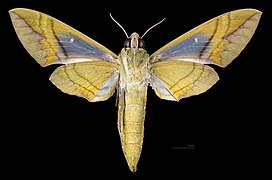Eumorpha labruscae
| Eumorpha labruscae | ||||||||||||
|---|---|---|---|---|---|---|---|---|---|---|---|---|

Eumorpha labruscae |
||||||||||||
| Systematics | ||||||||||||
|
||||||||||||
| Scientific name | ||||||||||||
| Eumorpha labruscae | ||||||||||||
| ( Linnaeus , 1758) |
Eumorpha labruscae is a butterfly ( moth ) fromthe swarm family (Sphingidae). With their appearance, the caterpillars can perfectly imitate a small snake.
features
The moths reach forewing lengths of 52 to 58 millimeters. Body and forewings have a green base color; the hind wings are dark bluish in the middle with a light spot; near the inner edge of the wing there is a red-orange spot that radiates towards the outer edge; the outer edge is mostly lined with yellowish tones. The color of the moths is not variable.
The caterpillars are reddish-brown in the first stage and have six easily recognizable, white spots around the spiracles . The head, thoracic legs , abdomen , pusher and base of the anal horn are bright orange-red. The rest of the very long anal horn is black with its tip curved forward. In the following three stages, the spots around the spiracles are lime green. There are several purple dots at the bottom of the thoracic segments. A well-demarcated eye spot is on the third thoracic segment. The body is spotted brown and black and resembles a snake skin. In the last stage the anal horn and all light drawings are missing.
The doll is mahogany brown and has a matt, smooth surface. The cremaster is quite wide and has a single short point.
Occurrence
The species is widespread in the Neotropics and occurs south at least to Bolivia , Paraguay and Argentina . But it also occurs in Florida , especially in the south. Caterpillar finds in northern Florida occur occasionally; What is unusual is a find of two fully grown caterpillars on maiden vines near Regina (Saskatchewan) in Canada . The persistent flyers are found as moths in large parts of the United States , albeit rarely and irregularly, such as in Texas , Michigan , Minnesota and Maine .
Way of life
The adults hatch in captivity in the morning, well after sunrise or just before midnight. The latter animals remain inactive until the next evening. The moths make squeaky noises when disturbed and also put the spores on their tibiae . In Florida, the species is rarely caught in light , but it is unclear whether this is only due to the fact that it has not yet been collected in suitable habitats. The moths were observed sucking nectar on Asystasia gangetica .
Flight and caterpillar times
In its tropical range, the species flies year-round in continuously successive generations. In North America, one generation of the moths fly in autumn.
Food of the caterpillars
The caterpillars feed on Cissus verticillata and Cissus sicyoides in Florida . Otherwise, one has the caterpillars Cissus incisa , Cissus verticillata , Cissus pseudosicyoides , Cissus alata , Eupatorium odoratum , Heusenkräutern ( Ludwigia ), Magnolia ( Magnolia ) parthenocissus ( parthenocissus ) and grapevine ( Vitis vinifera ) detected. In Peru they are only supposed to feed on Ampelopsis .
development
The females lay their eggs individually on the top and bottom of leaves, but also on the tendrils of the food plants. After hatching, the caterpillars seek out the young shoots of the plants. In the first stage they often rest on the reddish colored tendrils, where they can hardly be recognized. Later they tend to rest on the wooden parts of the plants. They are nocturnal. In the last stage, when disturbed, the caterpillars pull their head and the first two thorax segments back into the third, thickened segment, which means that their coloration perfectly imitates a small snake. The pupation takes place in a hole in the ground several centimeters deep in the ground.
supporting documents
Individual evidence
- ↑ a b c d e f g h i j James P. Tuttle: The Hawkmoths of North America, A Natural History Study of the Sphingidae of the United States and Canada. The Wedge Entomological Research Foundation, Washington, DC 2007, ISBN 978-0-9796633-0-7 .
- ↑ a b c d Sphingidae of the Americas. (No longer available online.) Bill Oehlke, archived from the original on January 23, 2011 ; Retrieved December 30, 2010 . Info: The archive link was inserted automatically and has not yet been checked. Please check the original and archive link according to the instructions and then remove this notice.
literature
- James P. Tuttle: The Hawkmoths of North America, A Natural History Study of the Sphingidae of the United States and Canada. The Wedge Entomological Research Foundation, Washington, DC 2007, ISBN 978-0-9796633-0-7 .




